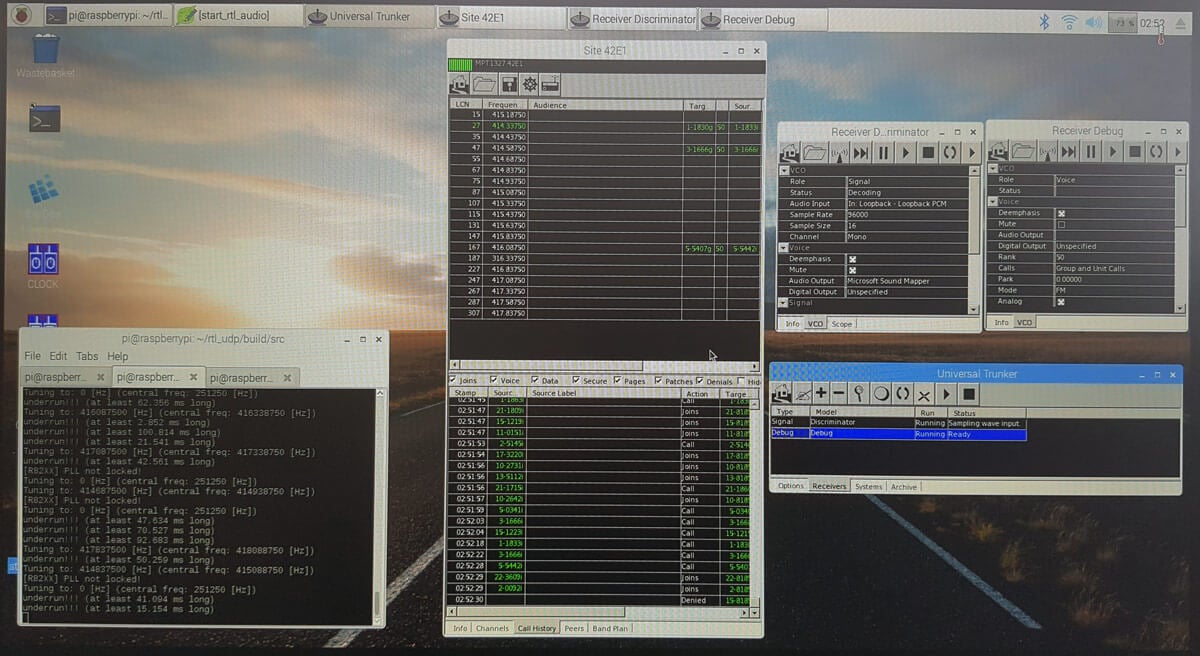Skywave Linux
- Sdr Radio Linux
- Best Sdr Software Linux
- Sdr Software For Linux Mint
- Sdr Software For Linux Mint Debian
- Sdr Software For Linux Mint 19 Cinnamon
Install Skywave Linux
Gqrx is fairly easy to install on a new Linux Mint 18.1 installation. The available packaged version is 2.4.1 and the version you get following these instructions is 2.6.1, so worth a little command line effort. I haven't tried with 2.4.1 so don't know if it works. Sdr is a session directory designed for announcing and scheduling multimedia conferences on the mbone - the multicast backbone of the internet. Sdr is loosely modelled on sd - lbl's mbone session directory. Sdr extends the sd model in a number of ways, particularly in the degree of detail about the timing and resources required by a conference, and in the provision of a much more flexible.
What is Skywave Linux
- NESDR is fully compatible with all known Linux distros. However, due to the wide variety of distros available, installation procedures can vary. A setup guide for a.
- Tsl-sdr (Linux) (Free) (Related Post) 'The Standard Library' is a set of tools and demodulators for software defined radio like the RTL-SDR. The main program is MultiFM which allows you to monitor multiple FM channels at once. Tsl-sdr also comes with a pager decoder. Dumpvdl2 (Linux/Windows) (Free) (Related Post) - VDL2 Decoder.
Skywave Linux is a Linux distribution built around the popular Ubuntu Linux Operating System. Skywave Linux comes with many popular SDR (Software Defined Radio) packages pre-installed. You can access Software Defined Radios all around the world allowing you to listen to Amateur Bands, Broadcast Bands, Short wave Radio, Utility Stations, Air and Marine from around the world. Connect a low cost RTL2832U based DVB-T dongles and use your computer as a multi-mode wide band radio receiver (SDR Dongles). Skywave Linux comes with the following packages pre-installed:
QtRadio - Allows you to connect and control SDR's all around the world.
CubicSDR - is a cross platform Software Defined Radio application that allows you to navigate the radio spectrum and demodulate signals.
Dump1090 - Software to enable you to revive Aircraft Location and speed information (ADS-B stands for Automatic Dependent Surveillance Broadcast) Aircraft plotted on maps in real time.
FLDigi - Software for use with Digital Mode Radio. Decode many popular digital modes including PSK31, BPSK31, PSK63, Thor, Throb, RTTY and many more.
WSJT-X - Software for the decoding of very weak signals using Digital Modes: JT4, JT9, JT65, WSPR and Echo.
To download the latest version of Skywave Linux, simply click on the download link below:
Download Skywave Linux
In the following example I am going to install Skywave Linux into Oracle's VirtualBox software. Oracle's Virtual Box can be downloaded and installed from the following link:
Download Oracle VirtualBox
Configuring VirtualBox for Skywave Linux
To configure VirtualBox for the installation of Skywave Linux, follow the steps below:
Create Virtual Machine
To create a Virtual Machine profile for the installation of Skywave Linux, Open VirtualBox and click on the 'New' icon in the upper left hand corner of the screen. At this screen menu, you must now provide a name for your Operating system. In the example I have selected 'Sky_Wave_Linux'. For OS type I have selected Linux and for the version I have selected 'Ubuntu (64 bit). Once you have entered this information, click on 'Next' to continue with the set-up.
Allocate Memory
Next you will need to allocate the amount of memory that you would like to assign to your virtual machine. In the example I have chosen to allocate 2GB of memory (RAM). Click 'Next' to continue.
Create a Virtual Disk
At this menu screen choose the option 'Create a Virtual Hard Disk Now'. Click 'Create' to continue.
Select Hard Disk Type
At this screen choose 'VDI (VirtualBox Disk Image). Click 'Next' to continue.
Select Storage Type


From this menu screen choose the option 'Dynamically allocated'. Click 'Next' to continue.
Sdr Radio Linux
File Location and Size
At this menu screen allocate 15GB of storage for your virtual machine. Click 'Create' to continue.
Configuring your display and Network
Once you have completed the previous step, you will now be back at the main 'VirtualBox Manager' screen. You should now be able to see your profile 'Sky_Wave_Linux' in the left hand of the screen. Highlight this option by clicking once on the name. On the right hand side of the screen you will see various settings that can be changed (General, System, Display, Storage, Audio, Network and USB). Next you will need to click on each of the sections below.
Display
From the main home screen 'Oracle VM VirtualBox Manager' click on the option 'Display'. At this screen select 'Enable 3D Acceleration' and allocate the amount of Video Memory you would like to give to your virtual machine. In the example I have allocated 32MB. Once you have made your changes, click on 'OK'
Network Settings

From the main home screen 'Oracle VM VirtualBox Manager' click on the 'Network' option. At this screen choose the option to use a 'Bridged Adapter'. This will make sure your system gets allocated an IP address within your normal network range. This will allow other devices on your default network to communicate with your system. Click 'OK'
Attach USB SDR Dongle
If you have a USB SDR dongle, then Insert this into your computer. From the main menu screen 'Oracle VM VirtualBox Manager' click on the 'USB' option. Down the side of this menu, there is a icon (green) in colour with a plus sign. Click on this, you will now be presented with a list of USB devices that can be attached to your virtual machine. From the list that appears, select your dongle. In the example my Dongle was recognised as 'Realtek RTL2838UHIDIR [0100]. Click 'OK' to continue.
Select Start Up Disk
From the home screen 'Oracle VM VirtualBox Manager' highlight your profile 'Sky_Wave_Linux' and then click on the 'Start' icon at the top of the screen. Now navigate to the location of the 'iso' image of Skywave Linux that you downloaded earlier. Select this file and then click on 'Start' to initiate the installation process.
Virtual Machine will now Start.
You will now see a screen similar to the one below.
Welcome Screen
From this screen we are going to choose the option of 'Install Ubuntu'. Click on the 'Install Ubuntu' button.
Preparing to Install Ubuntu
At this screen I have chosen the options 'Download Updates' and 'Install third party software'. Click on 'Continue'
Installation Type
Select the option 'Erase disk and install Ubuntu' then click on the button 'Install Now'.
Confirm - Write Changes to Disk
Before you can continue with the installation, you will need to confirm the following changes that are going to be applied to your disk. If you are happy to proceed, then click on 'Continue'. If you need to amend any settings, this is your last chance to go back and make any changes.
Where are you?
At this screen you need to choose your geo-graphic location. In the example 'London' has been chosen. You can either click on the map or type your location into the box. Once you have made your choice, click on 'Continue'
Keyboard Layout
At this screen you must choose the keyboard that matches your system. In this example I have chosen 'English (UK). Click 'Continue' once your keyboard has been selected.
Who are you?
At this screen you must create a new user. Simply fill out the relevant fields. I have chosen the option 'Require my password to log in'. This will mean that when the system starts, you will need to provide your password to access your system.
Installation Continues
Now further action is required at this part of the installation. Your installation files are now being copied to your disk.
Installation Complete
Installation is now complete. You will need to restart your system before you can use your installation. Click on the 'Restart Now' option.
Login Screen
If you chose the option to enter a password for access, you will be greeted with a login screen similar to the one below. (You will notice that your system has also been upgraded to the latest version Ubuntu 15.10). Enter your password into the box provided.
Desktop
You should now see a desktop similar to the one below. Applications can be accessed by clicking on the icons from the launcher located on the left of the screen. Initially a list of short cut keys is also displayed.
Best Sdr Software Linux
Launcher Icons
To access any of the pre-installed Radio Software, simply click on the relevant icon. From top to bottom the icons are:
CQ - Launches QtRadio Application
CubicSDR - CubicSDR Wide Band Receiver
Dump1090 - ADSB Flight Tracking Software
fldigi - Digital Mode Decoding Software
WSJT-X - Software for the decoding of very weak signals using Digital Modes: JT4, JT9, JT65, WSPR and Echo.
FireFox - Firefox Web Browser
Bitmask - Easy and Secure Encrypted Communication
Files - File Explorer
gedit - Text Editor
CQ - QtRadio
Sdr Software For Linux Mint
QtRadio allows you to access SDR that have been made available online. You may select one of the available SDR devices and control the radio remotely. Many of these radios cover the full Short wave HF Bands and Amateur Bands that are available.
CubicSDR
Sdr Software For Linux Mint Debian
CubicSDR is a Software Defined Radio (SDR) application which allows you to navigate the radio spectrum and demodulate any signals that are found. CubicSDR also provides support for low cost Realtek SDR Dongles (SDR Dongles). For more information, you may visit the CubicSDR homepage CubicSDR Home Page
Dump1090 - Decoding ADS-B

Dump1090 is an application that allows you to track aircraft traffic in real time using a Realtek USB Dongle. The aircraft are displayed on a map along with Flight Number, Altitude, Heading and Speed.When you click on the Dump1090 icon you will be asked to provide your Latitude and Longitude.
You can find this information by visiting the following website: Find My Longitude and Latitude. Once you have entered your information, you will be able to see aircraft displayed on a map similar to the image below.
fldigi
fldigi is an application that allows you to decode digital transmissions and display these easily. fldigi supports numerous digital modes including popular modes such as PSK31.
WSJT-X
Sdr Software For Linux Mint 19 Cinnamon
WSJT-X is a software application that allows you to decode very weak signals using Digital Modes: JT4, JT9, JT65, WSPR and Echo.
For more information regarding 'WSJT-X visit the following site WSJT-X
